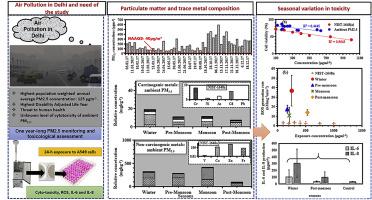Chemosphere ( IF 8.1 ) Pub Date : 2020-09-15 , DOI: 10.1016/j.chemosphere.2020.128305 Ananya Das , Gazala Habib , Perumal Vivekanandan , Arun Kumar

|
The fine particulate matter (PM2.5) was collected at academic campus of Indian Institute of Technology, Delhi, India from January-December 2017. The PM2.5 samples were analysed for carcinogenic (Cd, Cr, As, Ni, and Pb) and non-carcinogenic (V, Cu, Zn, Fe) trace metals and their elicited effects on carcinoma epithelial cell line A549. Toxicological testing was done with ELISA kit. Same analyses were repeated for standard reference material (NIST-1648a) represents urban particulate matter. The student-t test and spearman correlation were used for data analysis.
The seasonality in PM2.5 mass concentration and chemical composition showed effect on biological outcomes. The PM2.5 in Post-monsoon and winter had higher amount of trace metals compared to mass collected in pre-monsoon and monsoon. Following the trend in PM mass concentration significantly (p<0.5) lower cell viability was observed in post-monsoon and winter compared to other two seasons. NIST UPM 1648(a) samples always had higher cytotoxicity compared to ambient PM2.5 Delhi sample. Strong association of Chromium, Nickel Cadmium and Zinc was observed with cell viability and reactive oxygen species (ROS) production. Winter IL-6, IL-8 production were 2.8 and 3 times higher than values observed in post-monsoon and 53 and 9 times higher than control. In winter season trace metals As, Cu, Fe in pre-monsoon Cr, Ni, As, Pb, V, and Fe, in post-monsoon Cd and V strongly correlated with ROS generation. ROS production in winter and pre-monsoon seasons found to be 2.6 and 1.3 times higher than extremely polluted post-monsoon seasons which had 2 to 3 times higher PM2.5 concentration compared to winter and pre-monsoon. The result clearly indicated that the presence of Fe in winter and pre-monsoon seasons catalysed the ROS production, probably radical showed high cytokines production which influenced the cell viability reduction, while in post-monsoon PM majorly composed of Pb, As, Fe and Cu and affected by photochemical smog formation showed significant association between ROS production with cell viability. Overall, in Delhi most toxic seasons for respiratory system are winter and post-monsoon and safest season is monsoon.
中文翻译:

活性氧的产生和周围环境中的PM 2.5相关金属对人肺上皮A549细胞的炎症作用“一年的研究”:德里分会
细颗粒物(PM 2.5)于2017年1月至12月在印度德里的印度技术学院的学术园区内采集。分析了PM 2.5样品的致癌性(Cd,Cr,As,Ni和Pb)和非致癌性。致癌(V,Cu,Zn,Fe)痕量金属及其对癌上皮细胞系A549的诱导作用。用ELISA试剂盒进行毒理学测试。对代表城市颗粒物的标准参考物质(NIST-1648a)重复了相同的分析。学生t检验和spearman相关性用于数据分析。
PM 2.5质量浓度和化学成分的季节性对生物学结果有影响。与季风前和季风中收集到的质量相比,季风后和冬季中的PM 2.5具有更高的痕量金属含量。遵循PM质量浓度的趋势,与其他两个季节相比,季风后和冬季的细胞活力显着降低(p <0.5)。与环境PM 2.5相比,NIST UPM 1648(a)样品始终具有更高的细胞毒性德里样品。观察到铬,镍镉和锌与细胞活力和活性氧(ROS)产生密切相关。冬季IL-6,IL-8的产量分别比季风后的水平高2.8和3倍,比对照高53和9倍。在冬季,季风前Cr,Ni,As,Pb,V和Fe,季风后Cd和V中的微量金属As,Cu,Fe与ROS的产生密切相关。发现冬季和季风前季节的ROS产量分别是极度污染的季风后季节的2.6和1.3倍,季风后季节的PM 2.5浓度是冬季和季风前的2至3倍。结果清楚地表明,冬季和季风前季节铁的存在催化了ROS的产生,可能是自由基显示出高的细胞因子生成,从而影响细胞活力的降低,而在季风后的PM中,主要由Pb,As,Fe和Cu组成并且受光化学烟雾形成的影响表明ROS生成与细胞活力之间存在显着关联。总体而言,在德里,呼吸系统毒性最高的季节是冬季和季风后,最安全的季节是季风。











































 京公网安备 11010802027423号
京公网安备 11010802027423号